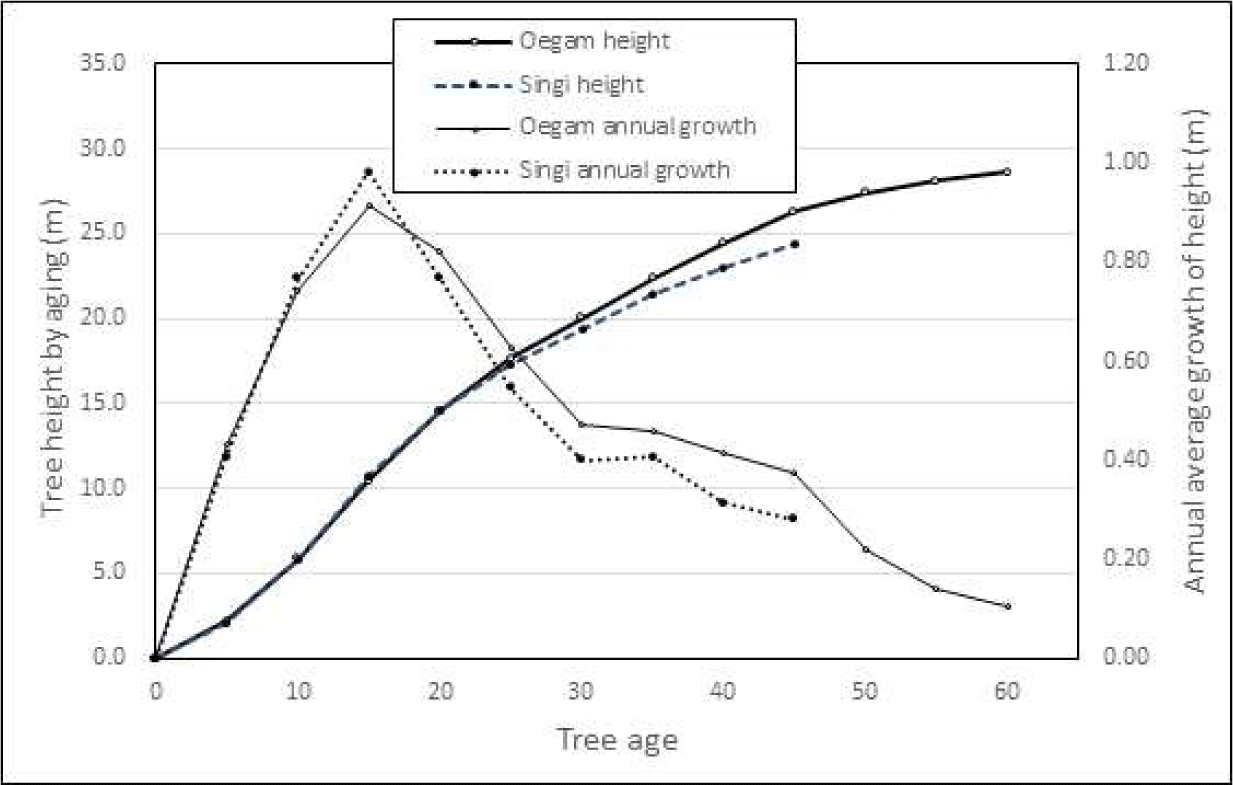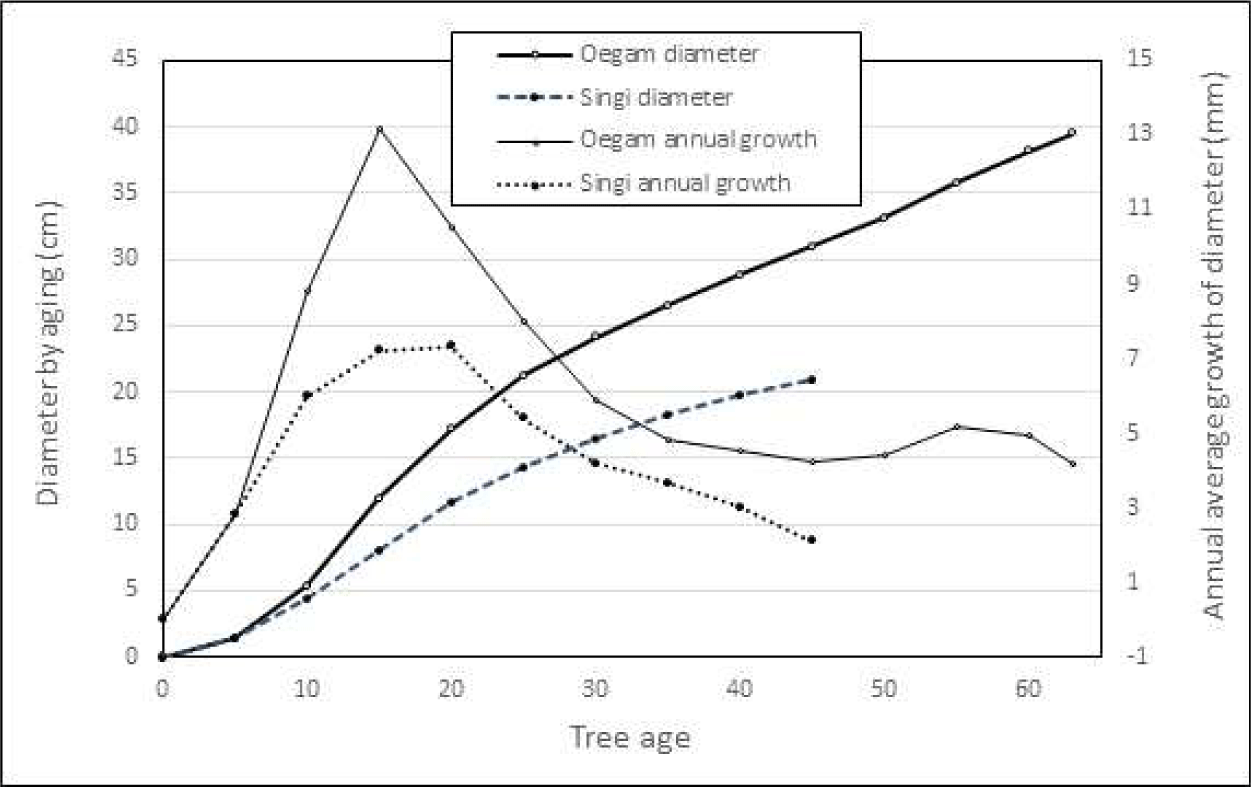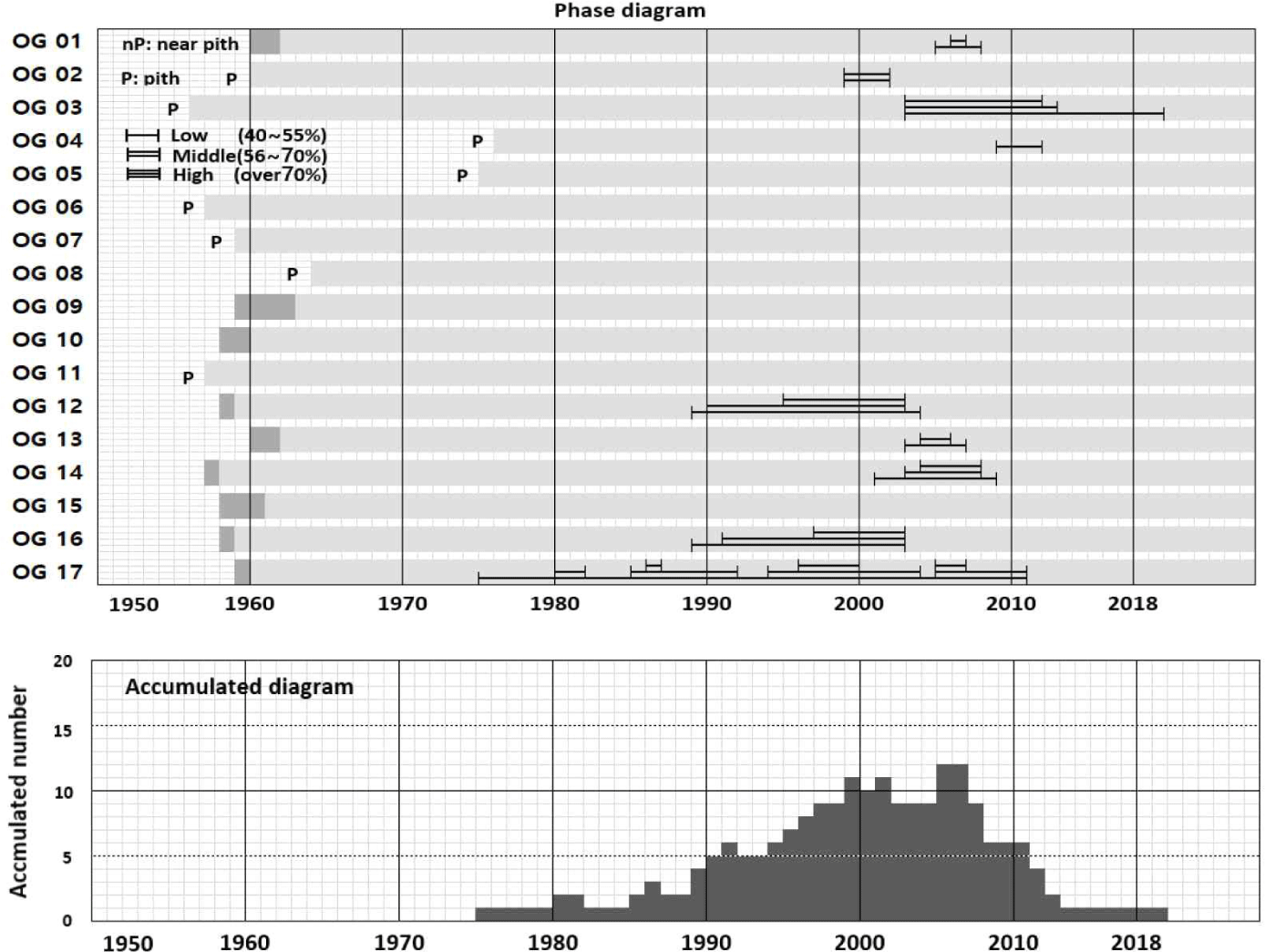1. INTRODUCTION
The public value of Korea’s forests was estimated to be 221 trillion won in 2018 (NIFoS, 2020). Among the various items of public value, greenhouse gas (GHG) absorption and storage, forest scenery, soil runoff prevention, and forest recreation account for the highest proportion. The issue of GHG reduction is a global concern and a national task. The most efficient way to reduce GHGs is to grow forests as carbon sinks and use wood (a mass of carbon) for long periods of time (Lee et al., 2022b). In the case of lumber, the annual decomposition rate is 0.0198% and the half-life is 35 years (IPCC, 2019). Therefore, growing trees of a diameter at breast height (DBH) class large enough to be used as lumber is one method. Ryu et al. (2016) reported that from 2010 to 2100, a reduction of 44 tCO2 per ha was expected in Japanese larch forests of age classes III and IV if a 10-year shorter harvesting period than that in the past was applied.
The Japanese larch [Larix kaempferi (Lamb.) Carrière], a species native to Mt. Fuji in Japan, was first introduced to Korea in 1904 (KFS, 2019). It adapted well with the Korean climate, and since the 1970s, it is the most widely cultivated species in the central and northern regions for timber products (Ko et al., 2019a). As of 2021, the Japanese larch plantations cover 4,721 ha, accounting for 22.9% of the total planted area of 20,599 ha, followed by cypress plantations (4,532 ha; KFS, 2022). From 2017 to 2020, cypress plantations covered the largest area; however, in 2021, Japanese larch was planted the most. Therefore, it can be said that the larch. is a highly profitable and useful tree species.
In Korea, forests in the adult stages of age class IV or higher account for 77.3% of the total forest area (KFS, 2022); therefore, it is time for active domestic timber production. The forest stock accumulation of Japanese larch is 56,564,208 m3, which accounts for 5.4% of the total forest stock (740,362,891 m3) and ranks fifth after pine, oak, other broad-leaved trees, and cypress (KFS, 2022).
Tree growth results in an increase in the amount of usable wood of economic value, and is very important in terms of carbon accumulation, which can reduce GHGs associated with global warming. In Korea, the Japanese larch has been estimated to store 20,485,765 tCO2, the second largest amount of carbon stored in major forest species after pine (106,916,773 Cton; Lim et al., 2021). Woody materials, which are carbon composites, have a considerably greater carbon storage effect when used as lumber than when used as a rapidly decomposing fuel or pulp material (Chang et al., 2018). The proposed half-life for lumber by IPCC is 35 years, whereas that for paper is 2 years (Lee et al., 2021). Therefore, the value of the Japanese larch, which is mainly used as a lumber material, is high.
Since the 2000s, with the development of processing technology for Japanese larch (Ahn et al., 2021; Fujimoto et al., 2021), its utilization as a high-value-added timber for building structural and interior materials has increased, and it is treated as an economic tree species. Larch wood is used in construction (structure, interior, and floorboards), civil engineering, paving, plywood, pulp, and charcoal (Choi et al., 2020; Oh, 2022; Song and Kim, 2022; Yoo et al., 2021). The sapwood is white and narrow, the heartwood is reddish-brown, and they are clearly distinguishable. Furthermore, the lumber over 60 years old is of high quality, whereas the younger trees have immature lumber and of poor quality (NIFoS, 2012). These trees are suitable for long-term lumber production because they have few twigs and grow into straight trunks (Lee et al., 2018).
It is noteworthy that since the cutting age of Japanese larch was set to 30 years, a significant area of Japanese larch forests that have just passed 30 years has been cut down. Most of the Japanese larch log production (67.6%) is utilized in the general domestic lumber industry with relatively high added value (KOFPI, 2019).
The wood of Japanese larch over 60 years old is of excellent quality, and it is the most utilized species in the domestic general lumber industry. So, it is necessary to track and analyze the growth of trees after the cutting age of 30 years.
There are several methods for lumber volume measurement, such as the form factor method (Honer, 1965), stem curve equation (Hjelm, 2011; Kozak and Kozak, 2003), and volume curve method (Johansson, 2014; Ko et al., 2019b; Lee et al., 2001; Seo et al., 2016). Among these, the stem analysis method can be used for detailed comparison and analysis of volume by age.
Therefore, the current study attempted to analyze the growth information of annual rings and heights by performing stem analysis on six Japanese larch trees over 47 years of age and to predict their growth changes in the future.
2. MATERIALS and METHODS
Samples were collected from the larch forests that were artificially planted in the late 1950s in Oegam-ri, Daedeok-myeon, Gimcheon-si, Gyeongbuk Province, and in the mid-1970s in Singi-ri, Goesan-eup, and Chungbuk Province. The geographical location of Oegam-ri is 35° 53′ 54″ N, 127° 55′ 28″ E, and Singi-ri is located at 36° 49′ 59″ N, 127° 47′ 23″ E. The forest in Oegam-ri is an artificial plantation and well managed by professional manager (Doklimga). By contrast, the Singi-ri area was originally owned by the clan, and after reforestation, little management has been done.
According to data from the Korea Meteorological Administration, the average annual temperature for the past 50 years (1973–2022), observed at the Gumi meteorological observatory, which is closest to the Gimcheon survey area, was 12.7°C, and the average annual precipitation was 1,063 mm. Moreover, according to meteorological data for the past 50 years observed at the Boeun meteorological observatory, which is closest to the Goesan survey area, the average annual temperature was 11.0°C, and the average annual precipitation was 1,276 mm.
For analysis, three Japanese larches were collected from the survey site in Oegam-ri, Gimcheon-si, and three from the survey site in Singi-ri, Goesan-eup. All of them were collected from the hillside, and an overview is shown in Table 1.
After the selected sample trees were felled at a height of 0.2 m from the ground, the first disc of thickness 5 cm was taken from the stump, and the second disc was taken at a height of 1 m from the stump to calculate the volume through sectional measurement using Huber’s formula. Subsequently, disks were sampled at 2 m intervals, and when the length of the last upper part was < 2 m, the last disk was sampled at a location 1 m from the position of the previous disk (Fig. 1).
The collected discs were transported to the laboratory, and the measuring surface was sanded for accurate identification of the tree-ring boundaries. The sanded discs were measured to 0.01 mm in four directions using a tree-ring width-measuring instrument (LINTAB, Rinntech, Heidelberg, Germany). The ring boundaries were checked under a stereomicroscope (SMZ800, Nikon, Tokyo, Japan).
An annual ring is typically formed in temperature zones, although a false or missing ring may form sometimes due to an abnormal climate during the growth period or due to natural or artificial damage from external sources (Seo et al., 2017; Stokes and Smiley, 1968).
Cross-dating was performed to identify false or missing annual rings and to assign the exact year when the actual annual rings were formed (Jeong et al., 2016; Lee et al., 2021; Schweingruber, 1988). Cross-dating is a graphical method in which the width of each annual ring is graphically plotted using Time Series Analysis and Presentation program (Frank, 1996), then overlapped and compared (Lee et al., 2018). The annual growth amount used for analysis was obtained by taking the average value of 4 directions, namely the long and short diameter directions and the orthogonal direction.
Using the stem analysis method, the annual ring widths were summed and recorded according to age at 5-year intervals. The height corresponding to each age was determined using the height curve method. The changes in both tree height and annual diameter growth were tracked to create a stem analysis diagram using Auto-CAD (ver. 2018).
The stem volume, excluding the bark, was calculated via sectional measurement method using Huber’s formula. The total stem volume was obtained by dividing the stem into stump, stem, and top parts, and adding the three parts.
Wood cores were collected to analyze growth-decline in the Oegam-ri area where annual growth first showed a decreasing trend followed by recovery. The cores were collected from 17 Japanese larch within a radius of 50 m around the stem analysis trees by using an increment borer. After grinding the cores with sandpaper, a growth-decline diagram was constructed based on the annual ring width data measured at 0.01 mm using an annual ring width measuring instrument following the method of Schweingruber (1990).
A more than 40% decline in annual growth than the preceding year and which continued for more than 3 years was considered a growth decline. From the degree of decline, a 40%–55% decline was classified as low stage, a 56%–70% decline was medium stage, and ≤ 71% was classified as high stage. These 3 categories were then plotted in Excel.
3. RESULTS and DISCUSSION
To conduct the stem analysis method, six Japanese larch trees aged 47–67 years were harvested. The annual diameter growth, height growth, and volume change were analyzed using the information obtained by measuring the collected discs with LINTAB which can measure up to 0.01 mm.
The results of analysis using a 1.2 m high disc among the collected discs are shown in Fig. 2. The first annual ring on the stump part of the trees collected from Oegam-ri, Gimcheon City was formed in 1957, and the annual ring on the 1.2 m high disc appeared in 1958–1965. Furthermore, the first annual ring on the stump part of the tree felled in 2022 in Singi-ri, Goesan-eup was formed in 1975. The annual ring on the 1.2 m high disc appeared between 1978 and 1980. Therefore, it can be estimated that the period required for the tree to grow to a height of 1.2 m after forestation of Japanese larch was approximately 1 to 8 years. However, it was found that two out of three trees felled in Oegam-ri grew to a height of 1.2 m within 3 years, and it is estimated that the Oegam-3 tree took 8 years due to a problem in the establishment process. It was found that all three trees that were cut down in Shingi-ri grew to chest height within five years.
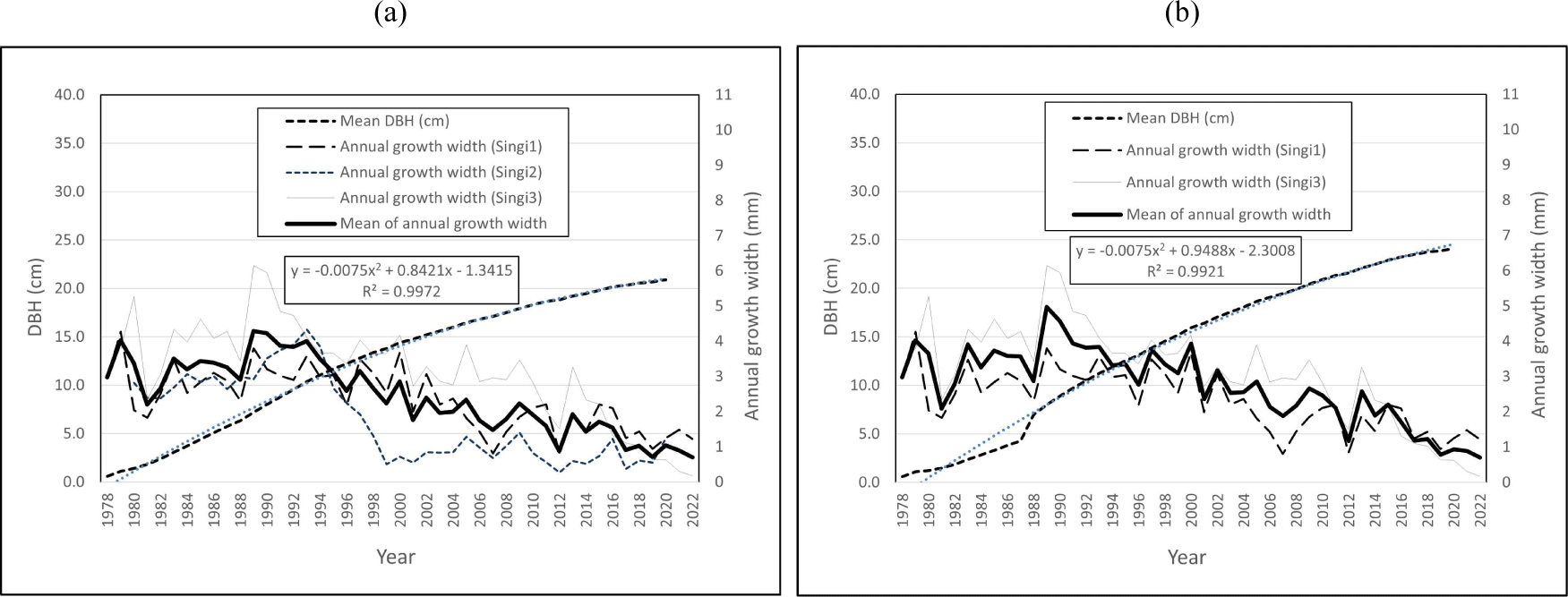
A cross-dating study was also performed on the annual growth values of the three trees collected from Oegam-ri and Singi-ri. The annual growth width was found to be either large or small in a regular pattern according to the year, as shown in Fig. 2. This was presumed to be due to the influence of the meteorological conditions of the current or previous year, and the overall diameter growth decelerated after 10 years old.
For the samples collected in Oegam-ri, the diameter growth displayed a steady increase until the tree was 63 years old, and the DBH, excluding the bark, was 35.4–42.6 cm. However, for the samples collected in Singi-ri, when the tree was 45 years old, the DBH, excluding the bark, was 14.5–20.9 cm. Since the diameter growth increases with the age of tree, a regression equation (Y = –0.0075X2 + 0.8421X – 1.3415) for tree age and DBH was derived, as shown in Fig. 2(a). The diameter of a tree age of 63 years was found to be 21.9 cm, indicating that the growth was much lower than that in the well-managed Oegam-ri areas. The Singiri-2 tree also showed a relatively low growth. Therefore, even after excluding it and applying the regression equation (Y = –0.0075X2 + 0.9488X – 2.3008), the DBH was 27 cm at 63 years age of the tree [Fig. 2(b)]. Therefore, a large difference existed between the trees grown in consistently managed and unmanaged areas.
The results of the stem analysis of three Japanese larch trees planted in 1957 at Oegam-ri, Gimcheon-si, are shown in Fig. 3.
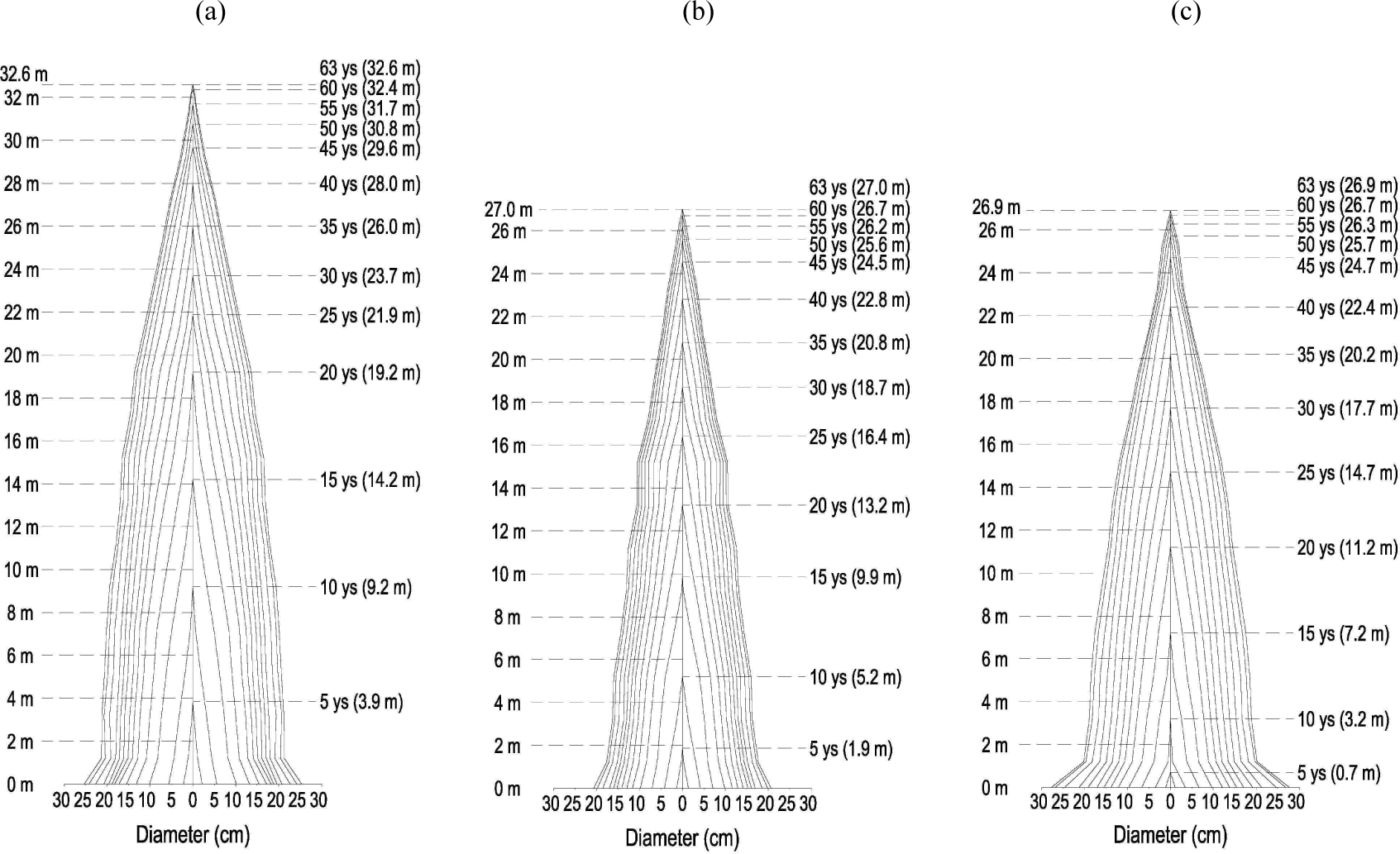
For the Oegam 1 (Table 1) grown in the lowlands, the height was 32.6 m, DBH was 42.6 cm, and period required to grow to breast height (1.2 m) was one year. For the Oegam 2 grown at a relatively high altitude, the height was 27.0 m, DBH was 35.4 cm, and the period required to grow to 1.2 m was three years. In the case of the Oegam 3, the height was 26.9 m, DBH was 40.5 cm, and the period required to grow to breast height was eight years.
The stem analysis results of three Japanese larch trees planted at Singi-ri, Goesan-eup in 1957 are shown in Fig. 4.
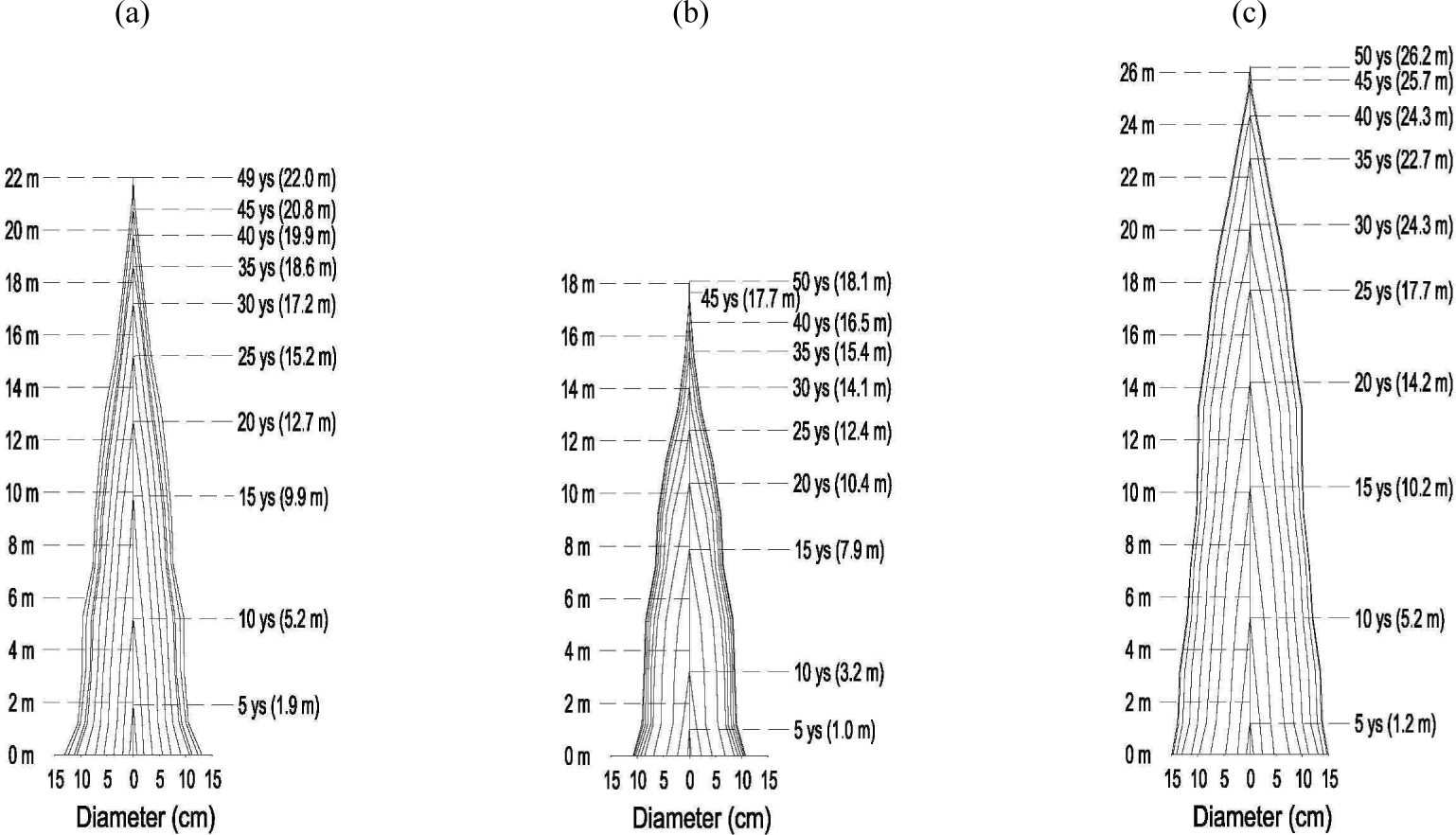
For the Singi-1 tree grown in the lowlands, the height was 22 m, DBH was 21.1 cm, and period required to grow to a height of 1.2 m was three years. In the Singi-2 sample, the growth was relatively low, and the sample died by 2020. The height was 18.1 m, DBH was 16.1 cm, and period required to grow to 1.2 m was five years. For the Singi-3 sample, the height was 26.2 m, DBH was 27.6 cm, and period required to grow to 1.2 m was four years.
As described above, even in the same forest land, there are severe deviations in height and diameter growth depending on the topography, and there is a large difference depending upon the management method of young trees.
The DBH data of the 6 sample trees (Table 2) showed that there is a large difference in growth between the trees of Oegam-ri and Singi-ri and this difference existed even after 30 years, i.e. when the trees are fully matured. Such difference can be attributed to the tree management system, which was present in Oegam-ri after artificial reforestation but not in Singi-ri. To note, even in the Oegam-ri area, where growth was good, the period required to grow into a large-diameter class (over 30 cm) was at least 35 years. Even in managed areas, DBH reached ≤ 30 cm at an average tree age of 45 years (Table 2).
Fig. 5 compares the average values of the two regions by analyzing the height growth according to the tree age of the six samples. As shown in Table 2, the sample trees grown in the two regions showed a large difference in diameter growth at the same tree age, although no significant difference in height growth was observed (Fig. 5). Furthermore, the annual height growth increased rapidly to a maximum of 1 m in the first 15 years of tree age in both regions, followed by a gradual decrease with increasing years. After 30 years, the annual height growth decreased to less than 0.4 m.
However, the diameter growth of the samples collected from Oegam-ri and Singi-ri showed a large difference (Fig. 6).
The annual diameter growth of Japanese larch in the Oegam-ri area was the largest (12.9 mm) when the trees were 15 years old, whereas when the age was 20 years the maximum value was 7.3 mm in the Singi-ri area. Thereafter, the annual diameter growth decreased steadily until the trees were 45 years old. By contrast, the diameter growth in the Oegam-ri trees increased again after 45 years (Fig. 6). Therefore, the degree of growth decline of trees around the sample collection site in Oegam-ri was analyzed, as shown in Fig. 7.
Analysis of the cores of 17 same species trees in the Oegam-ri area showed growth decline in 9 trees (Fig. 7). In sample no. 17, a minor decline was observed after approximately 15 years, which was the first thinning period, and the growth decline progressed for > 35 years. For samples 12 and 16, the decline progressed for approximately 15 years after 30 years of tree age, and then recovered. Sample no. 4 experienced a mild growth decline for 3 years after its 31 years age and then recovered. In five out of the nine samples, after 39 years of tree age or more, the growth decline continued for approximately 3 to 8 years and then recovered around 2010. Surprisingly, in sample no. 3, the decline started after 47 years of tree age and continued without any recovery.
As described above, the progression of growth and decline in Japanese larch were found to depend on management, although growth decline can be reversed even after 50 years of tree age. Therefore, forest maintenance, such as secondary thinning, is important around 30 years of tree age when growth decline begins. Even if the timing is somewhat delayed, growth decline can be recovered by proper management practices, such as thinning and fertilization.
The final age of maturity of tree species is set by law because it regulates the minimum age at which logging can occur. For Japanese larch, the final age of maturity is 30 years. Therefore, when the age of a tree reaches 30 years, it can be felled with permission from an administrative agency. The change in tree volume can be evaluated through stem analysis, and from such evaluation, we compared the timber volume at 30 years with that at 35, 40, 45, 50, 55, and 60 years (Table 3).
As shown in Table 3, the samples collected from the well-managed Oegam-ri area after artificial reforestation were more than 60 years old. When these trees were 30 years old, the single timber volume was 0.311–0.7772 m3, showing a large deviation, and the average volume of the three trees was 0.4847 m3. When the trees were 40 years old, the average single timber volume was 0.811 m3, which increased by 1.67 times compared to that at 30 years. The timber volume increased 2.49, 3, and 3.49 times when the trees were 50, 55, and 60 years old, respectively. On the other hand, the tree ages of the samples collected from Singi-ri areas that were not well managed after artificial reforestation were > 45 years. When the age of these trees was 30 years, the single-tree volume was 0.0948–0.3311 m3, showing a large deviation, like the trees collected from the managed area. When the trees were 40 years old, the average single timber volume was 0.3456 m3, which increased by 1.76 times compared to that at 30 years, and it was found that the timber volume increased 2.08 times when the trees were 45 years old. However, the average volume of the three trees was 0.1956 m3, which was significantly different from that of trees of the same age in the Oegam-ri area.
The Japanese larch grown in these two regions had different growth environments, such as climate and topography. However, when focusing on the two areas, well-managed and unmanaged, after artificial reforestation, the Japanese larch grown in the well-managed area showed a volume difference of > 2.4 times when they reached 30 years of age. These findings highlight the importance of forest management. In addition, it was determined that the volume when the tree age was 45 years increased by 2.08 times in both regions compared to that when the age was 30 years. Therefore, in the Japanese larch, the volume growth increased steadily for at least 45 years even under unfavorable growth conditions.
After investigating 2,752 Japanese larch trees of age class VI or higher in a previous study, the incidence of heartwood decay was shown to be low by approximately 2.2%–3.4%, and the decay size was reported to be small with a diameter of 2–4 cm (Park, 2007). In the present study, there was no trace of heartwood decay in the three trees at 47 years old or the three trees at 63 years of age.
4. CONCLUSIONS
Stem analysis of Japanese larch obtained from the forests in Oegam-ri and Singi-ri regions with different growth environments showed that height first increased rapidly up to 15 years of tree age after which it decreased gradually. After ≤ 30 years, the annual height growth tended to decrease to < 0.4 m. However, there was a large difference in diameter growth between the two regions, and the annual diameter growth showed a gradual decline after a peak at 15–20 years. This difference in diameter growth leads to a difference in volume. In this regard, it can be stated that initial management after artificial reforestation is very important so that diameter growth does not slow.
Furthermore, the average annual volume (volume/age) of the trees in the Oegam-ri region of age 20 years, was 0.009783 m3 at the age 20 years, 0.016157 m3 at 30 years, 0.020276 m3 at 40 years, 0.0242 m3 at 50 years, and 0.028173 m3 at 60 years. For the Singi-ri trees with poor growth, the average annual volume was 0.003253 m3 at 20 years, 0.006521 m3 at 30 years, and 0.008639 m3 at 40 years. Here, the growth was relatively low and slow and reforestation is necessary.
In this study, the tree volume of Japanese larch was found to increase steadily up to 60 years of age even if the annual height and diameter growth slowed. The timber volume at 60 years increased 3.48 than that at 30 years age. Even after 50 years, growth decline showed signs of recovery, depending upon the management efficiency. Therefore, in terms of forest management, long-term logging, which does not require repetitive investments in reforestation or management costs, may be more efficient than short-term logging. The logging of Japanese larch should be decided after fully considering various factors, such as forest management and site conditions.


